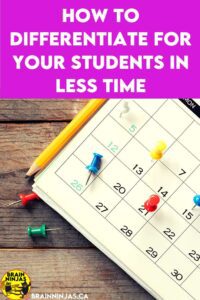
One of the biggest issues teachers talk about is how much time it takes to differentiate their instruction for the needs of the different learners in their complex classrooms. All teachers want to help, reach and teach all their students, but understanding how to do this can be a challenge especially for teachers who are new to teaching, new to a grade level or new to the types of challenges and barriers a student is facing.
Full Disclosure: Differentiated instruction is hard.
And there seems to be some sort of unwritten out there that everyone should be good at it the first time you try.
Gee, no pressure.
Well, what if we could give you some tried and true strategies that have worked for us? We all know differentiation is important, but what does it mean to truly differentiate for everyone?
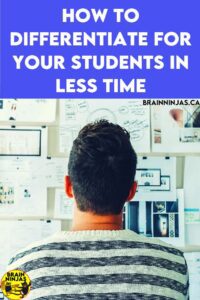
Let’s Look at a Differentiation Analogy
Imagine you are driving down a road toward a destination. You know where you want to go, but there are some potholes making driving quickly interesting. Maybe there are some cows on the road. Maybe you lost your map. Your journey to wherever you are going has some barriers. Not your fault. That’s life.
Now, imagine you are going to the same place but someone has paved over the potholes on the road or given you a map. Maybe there’s a fence to keep the cows away.
But you are still on the same road going to the same place.
This is differentiation. All roads are leading to the same place or the same expectations, but you might be getting different things that help you along the way.
And This is Where Most Teachers Stray
When you hear differentiation, you might assume that means different. Different tools or strategies, yes. But the journey is the same.
In our classroom, we sometimes joke about this being called the scenic route.
Here’s the Catch
The road is open to everyone. All the paved potholes, cows fences and maps are available to everyone. Instead of planning a separate route for a few students, all your students are on the road. They all have access to the same things that reduce their barriers to learning. The expectation is they will all get there at some point.
How Does This Apply in the Classroom?
You need to have a toolbox of strategies that are available at all times for all your students. They will begin to select the things that work best for them and you will have to do less and less of the planning for differentiation, because the road is the same for everyone and your students choose the tools they need to drive on that road successfully.
Maybe say it to yourself a few times: students do the differentiating, not me.
If you haven’t signed up for our email list, get your Differentiation Planning Guide. It can also be found in our Resource Library, along with many other general classroom forms to help you organize your classroom.
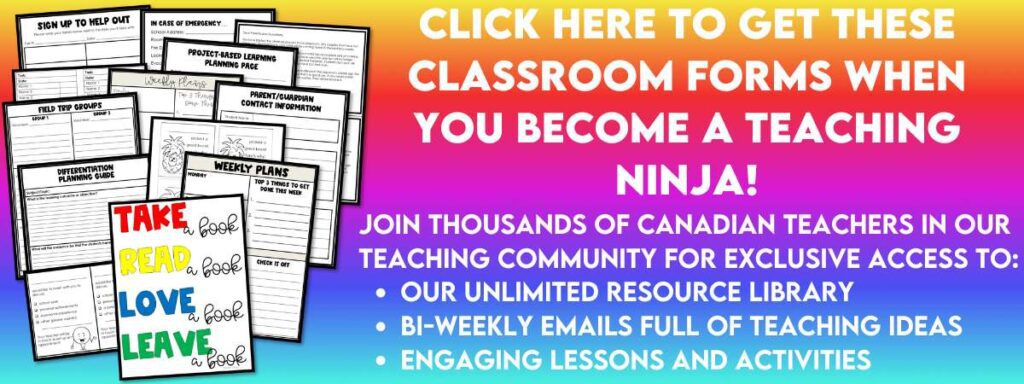
This guide goes through the steps described in this post and gives you an opportunity to work through your lesson planning.
Here are some basic strategies we consistently use for all of our students:
How to Differentiate Physical Classroom Conditions:
- Various writing tools available including pencils, pens, Flair pens, Sharpies, digital devices. We regularly teach students to use all the tools and how to choose the right tool for the job.
- Various paper options available: coloured, lined, not-lines, raised lines, different sizes and when possible different textures
- FM System or Voice Amplifying System to help reduce classroom noise and make the speaker voice clearer.
- Visualizer or Document Camera so you can show students exactly what you are talking about on pages, model writing, model reading and show basically anything you want to the whole room
- Digital Screen/Interactive Whiteboard with sound if possible to help show different types of media or reinforce concepts as they are being learned
- Seating options or flexible seating options so students can sit comfortably when working. This includes opportunities to move, wiggle or stand when working such as standing desks or counter space.
- Storage areas that belong to students. Even if you use communal supplies, students should have a space in the classroom that is exclusively theirs.
How to Differentiate During Planning
When you are planning your lessons, consider the needs of your students. This is the approach we take when planning.
First: What is it we want students to be able to know, do, understand or demonstrate?
Second: How will we know they have done this? What will the evidence be?
Third: What will my students need in order to show me they can do this?
So, let’s say you want students to demonstrate they can solve a multiplication problem where they must multiply two digits by two digits. Let’s work through the planning.
Day One
First: Students will be able to multiply a two-digit number by another two-digit number. (This is what we want them to do.)
Second: They will be able to answer three questions correctly. (This is how we’ll know they’ve done it.)
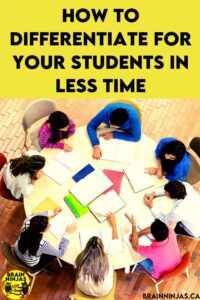
Third: They will need a lesson on how to multiply two-digit by two-digit numbers. I will teach the traditional algorithm to the whole class first. We will practice on whiteboards. Students will be allowed to use multiplication charts or calculators to go through the process of the questions. We will practice while I observe students. During this time I will encourage the students who do not need the support of a chart or calculator to try it without.
Depending on how many students are still struggling with the process (more than 7), I will introduce Lattice Multiplication as a strategy. I will teach this strategy to the whole class. We will again practise using charts and calculators if needed. Usually, this process is easier for students, but we will continue to practice.
I will have students do a quick assessment. Are they having trouble with the steps (remembering the steps in order) or are they having trouble with the math (knowing their times tables)? Or are they having a different problem? I will take note of these different needs and use them to plan the next lesson.
Day Two:
First: Students who want to try a worksheet on their own are free to do this. I also challenge students who’ve mastered the algorithm to make up their own more difficult questions and quiz each other. Students who need help with the math are given tools like charts or calculators so they can work independently until I’m ready to work with them.
Students who are struggling with the process work through another lesson with me in a smaller group. But, here’s the catch, anyone is welcome to join the small group review. We basically break down the first day lesson again a little slower, practicing each step as we go. During this time I can see if there is something getting in the way of learning. This is when I can personalize what they need, like making them a sequence chart for their math book or making a mini chart for the group that they can place in their math books.
Remember, the goal of the lesson is to be able to answer three questions correctly. Nowhere does this mean completely independently without any supports. That is of course the goal, but that will come with time and practice for most students.
Day Three:
It’s time for a quick assessment. Give the class three equations and any supports they need to do them independently from teacher support. Remove extra words or directions from the page so it is simply math equations. Use lots of white space on the page to help keep students from feeling overwhelmed.
Tell your class that everyone can get their tools (we often use our interactive notebooks at our desks as a tool) and get comfortable because everyone will be staying until everyone has answered three questions. Make sure you tell them that it is not a test, but just a check to see what they already know or need to practice.
Give them as much time as they need. Students who finish can just read silently at their spot without moving. This will let the ones who need more time work.
I Can Hear the Doubt
You might be thinking, I don’t have time for all that for every single outcome.
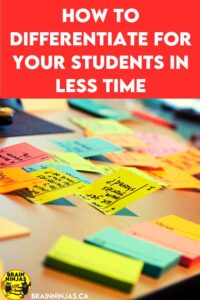
You’re right. You don’t. That would be crazy. This is where your professional judgment comes into play. Think about the outcomes for your subject area. Which ones do your students need in order to be successful in life? Which ones are worth knowing about, but mastery isn’t as important?
Differentiate for the “absolutely must learn and do.” The other outcomes don’t need as much time and attention. For these outcomes you strictly remove barriers. If your students can’t read but you want them to understand a passage from a textbook, read it to the whole class and discuss it so everyone understands. If you have a student who doesn’t understand English, does it matter if they know about the British North America Act today? No, they need to learn basic English, so listening to you and the class talk is all they need from that lesson.
Here’s a Friendly Analogy
You know the episode of Friends where Joey writes a reference letter to the adoption agency on behalf of Monica and Chandler? He learns to use a thesaurus and then uses it on every single word so nothing makes sense.
That’s differentiation. It doesn’t make sense for every single outcome.
Back to the math lesson. This is where assessment comes in. These would be my report card comments if it was the end of the term for the multiplication.
Monica can do long multiplication of two digits by two digits independently and accurately without supports or tools.
Rachel can do long multiplication of two digits by two digits independently using a multiplication chart. She needs to continue to memorize her multiplication facts.
Joey can do long multiplication of two digits by two digits with teacher support and tools such as a multiplication chart. He should continue to practice this skill to work toward independence.
Why Did I Include Assessments Here?
If you don’t know where you’re going, how will you know you’re there? I write the possible report card comments during the planning phase. This keeps me clear on the expectations and I don’t even need a test to confirm what I know students can or cannot do. I’ve done that during the lessons.
The only time you need a test is when you don’t know how much they know. Or, if you’re trying to teach them how to write tests.
How to Differentiate With Teaching Strategies

When you’re teaching there are lots of different ways you can teach your students. As you get to know them better, you can change up how you teach to help them learn best. Hint-it’s probably not the way YOU learn best.
- Read it aloud. Not only does this model correct reading and fluency, you can model the thinking process during reading and make sure students are understanding as you go.
- Record yourself. Whether it’s a video or an audio recording, having this can help students who need more time watch/listen again. You can also flip your classroom giving your independent workers a chance to learn on their own.
- Technology and accessibility tools. There are all kinds of apps and tools that can read online material to students. Even having students use this on their own writing can help them in their own editing process.
- Whole Group Instruction can be great as a starting point or wrap up activity. Almost every lesson, unit or activity can start as a whole group activity.
- We save the Small Group Instruction for specific things like Guided Reading, Guided Math, Guided Writing, enrichment activities and remediation or reinforcement activities.
- Hands on activities when it works for the task.
- Project Based Learning is great for students that can manage their time and projects. For the ones that can’t, we support them though guidance, but they are usually so engaged that it’s more of an organization lesson than a teaching lesson.
- Independent study can be great for students that want to extend their learning. The best part of this one-they come up with the what and the how. You just give them a time to share what they’ve learned.
- Mix it up whenever and however you can. If a student struggles in math but is a strong reader, then make sure they are with like-minded learners depending on the needs for that subject and that activity. Slower learners can learn from faster learners and faster learners can learn from slower learners.
- Avoid peer teaching where it’s unbalanced. This means, pair kids up with similar abilities rather than a strong skill set with a weaker one. Balance it out so everyone feels like they have a strength.
It feels like this is only the tip of the differentiation iceberg. Be sure to check out some of our other posts on differentiation. Debunking Five Differentiation Myths and How to Differentiate Your Instruction which have even more tips for you.
If you are struggling with differentiation in your classroom, please reach out to us. This is our passion and we feel wholeheartedly that all students deserve differentiation, but all teachers deserve a life.
Let us know what is working or what isn’t, in the comments below.







These tips are so helpful. We often think differentiation happens during lesson planning and assessment. But your tips about changing the physical classroom and making tweaks to teaching strategies count just as much. I always tell myself that the best first step in differentiating my instruction is to build relationships with my students. Great ideas in this post!!